
Figure 2.16. Yard Turnouts.
2.15.
CROSSOVERS AND SIDINGS
To divert trains on multiple-track main lines, a crossover is provided. To permit opposing trains to pass
or to allow a faster train to pass a slower one on a single-track line, a siding is provided. Although the purposes of
these two types of turnouts are similar, their designs differ, as the following subparagraphs point out.
a. Crossovers. On multiple-track main lines, it is often necessary to provide routes so that trains may be
diverted from one parallel track to another for passing, reaching station platforms, and getting off the main line.
Two turnouts with a track between them, known collectively as a crossover, provide the means for moving trains
from one track to another. Figure 2.17 depicts a typical crossover. Sharp turnouts must not be used in crossovers
unless mainline speeds can be restricted. The turnouts should, if possible, be of the same size. And to avoid too
many compromise joints, turnouts should be of the same rail section as the track they join whenever possible.
Crossovers are generally remotely controlled and must be if a group of them is interlocked.
46



 Previous Page
Previous Page
